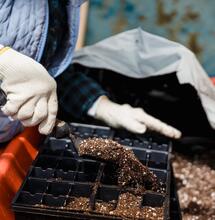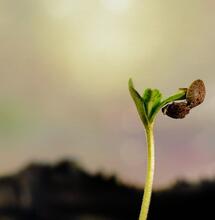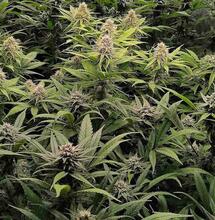A Beginner’s Guide To Cannabis Genetics

It is safe to say that we are now at the pinnacle of breeding Cannabis plants, which has allowed us to have such a wide diversity when it comes to indoor and outdoor application. There are more seed banks and breeders than ever before and that means the number of different strains now existing on the planet is at an all time high. In this article we explain all about Cannabis genetics, the different types, and 3 top tips.
Landrace Cannabis Genetics Explained
Before discussing the modern day hybrids with sky-high THC levels and off the chart terpene profiles, it is important to start with landrace Cannabis strains. Basically a landrace refers to a Cannabis plant that is found naturally growing in a specific area of the world and has co-existed with its environment for centuries.
It is during this time when pollination will occur naturally or with the aid of locals, who will continue to work a seed line allowing the most desirable traits to become prevalent in the future generation Cannabis seeds. Consider it as the weakest traits are pushed out and the strongest and most desirable traits are kept.
Examples of where landrace Cannabis genetics can be found growing in a natural, wild setting are Afghanistan, India, Nepal, The Himalayas,Thailand, Mexico, Jamaica, Morocco, and South America.
Indica Cannabis Genetics
Indica Cannabis will refer to plants that grow with a certain characteristic that are typically short, squat, and with thick and fat fan leaves. Flowering time on a full-blooded indica can be as fast as 50 days and normally ranging between 7-8 weeks.
The internodal spacing will be short and once flowering starts, the stretch will not be aggressive and plants will double in height, where they will flower producing dense, golf ball sized buds. The effects of indica Cannabis are usually physical, heavy hitting with a sleepy, heavy-bodied sedation. Indica strains can be found in Afghanistan, India, Pakistan, and the Hindu Kush mountains and will have become interbred over time making them a purebred line (IBL).
- Indica is short and fast flowering plants with a high resilience to outdoors.
- Perfect for growing in a Sea of Green set up with many small plants together.
- Indica is great for growers with limited height and requires little maintenance.
- Best for evening times and ideal for medical patients who need physical relief.
- The flavor and aroma will usually be a mix of fruity, earthy, gas, spice, and sandalwood.
Sativa Cannabis Genetics
Unlike indica, and the devastating effects they can have when smoked, sativa are totally different in terms of the effect and most importantly how fast and vigorous they grow. Normally found in more tropical parts of the world such as Mexico, Hawaii, Thailand, Columbia, North Africa, and Asia and have been naturally worked into an interbred line (IBL) over time.
Sativa genetics can grow very tall, produce a large number of side branches and flowers, and the effect can be a soaring, euphoric, creative, electrifying cerebral rollercoaster that can lead to overwhelming feelings of anxiety and paranoia in some cases. Flowering time can take between 10-14 weeks depending on the strain, and outdoors are best grown in climates that experience hot summers.
- Sativa Cannabis plants are better for growers with experience especially indoors.
- The terpene profiles will range from sweet, fruity, tropical, frankincense, and citrus.
- The leaf structure is normally long and thin with serrated tips and long petiole.
- The internodal spacing will be large and with an abundance of long and thin side branches.
Hybrid Cannabis Plants
Hybrid Cannabis strains are created when an IBL line is crossed with another IBL, or a line that is at least the 5th generation. This is where the term ‘ hybrid vigor ‘ originates from and will display the best of both parental lines and essentially have evolved into the next generation.
It is within the gene pool of hybrid Cannabis plants that different phenotypes and traits will become visible that is an expression of both parents then ultimately a mix of the two. Some good examples of hybrid Cannabis strains are White Widow, White Rhino, Skunk #1, Jack Herrer and AK47 just to name a few of the old school original breeding blocks that originated during the 1990's in Holland after a major push into the breeding world.
- Hybrid vigor is expressed when a plant has enhanced original traits from both parents.
- Phenotypes will vary much more in characteristics, height, structure, and terpenes.
- Breeding hybrids is a great way to open up a gene pool and keep stability.
- Cannabis hybrids also can become interbred and worked until the 8th generation.
Polyhybrid Cannabis
This pretty much covers the modern-day gene pool and refers to when a Cannabis strain has multiple parents from both sides that have been added over the generations. An example of a polyhybrid is cross Girl Scout Cookies with White Widow, which on paper carries the DNA of the cookies parents being OG Kush and Durban Poison and the Brazilian sativa and South Indian indica.
The majority of the Cannabis seeds that are available today in regular or feminized form will be poly hybrids, due to the ever changing and high demanding market place. Unfortunately this is why many of the Cannabis strains grown out will often display some type of mutation resulting in unstable plants that have tendencies to hermaphrodite.
Autoflowering Ruderalis Cannabis Plants
Autoflowering Cannabis plants changed the way growers look at outdoor crops and were able to work with a cultivar that could flower independent of the light cycle. Autoflowering Cannabis seeds can take between 9-12 weeks from seed to harvest and can be grown 3-4 times per year outdoors especially those who experience hot climates and long Summer periods. Autos are extremely popular throughout Europe, South America and now are part of many American growers outdoor patches.
- Autoflowering Cannabis does not require 18/6 to grow and will flower automatically
- The final plant height will be between 70-120cm depending on the strain.
- Excellent for keeping a low profile and very stealthy plants.
- Autoflowering Cannabis plants are great for terraces and balconies.
- Maintenance is very low with autos and a good choice for beginners.
Hemp / CBD Cannabis Plants
Hemp has grown naturally on the planet for thousands of years and has an incredible ability to remove heavy metals out of the earth. A highly resourceful material that originates back to the times of when ship sails and rope were made from Hemp. The cannabinoid profile of hemp will be less than 1% THC and higher in CBD, which has paved the way for the medical grade CBD hybrids that have dominated the medical scene in recent years.
Good examples of CBD Cannabis hybrids that were created by crossing hemp varieties with high THC strains are Charlotte's Web, Cannatonic, Remedy, ACDC, Harle-Tsu and Sour Tsunami.
3 Top Tips on Choosing The Best Genetics
- Indica Cannabis strains will grow small, not stretch much and finish at a medium height. These are an excellent starting point for a beginner grower.
- Sativa Cannabis can be tricky to grow and do require more space, maintenance and can be greatly demanding during the flowering period. A good choice for a grower with some experience and is confident with plant training.
- Breeding your own Cannabis seeds is easy to do and can be done on a small scale at first. It is a good idea to have a goal in mind before you start the project.








